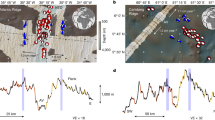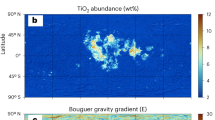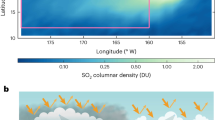Abstract
During Neoproterozoic Snowball Earth glaciations, the oceans gained massive amounts of alkalinity, culminating in the deposition of massive cap carbonates on deglaciation. Changes in terrestrial runoff associated with both breakup of the Rodinia supercontinent and deglaciation can explain some, but not all of the requisite changes in ocean chemistry. Submarine volcanism along shallow ridges formed during supercontinent breakup results in the formation of large volumes of glassy hyaloclastite, which readily alters to palagonite. Here we estimate fluxes of calcium, magnesium, phosphorus, silica and bicarbonate associated with these shallow-ridge processes, and argue that extensive submarine volcanism during the breakup of Rodinia made an important contribution to changes in ocean chemistry during Snowball Earth glaciations. We use Monte Carlo simulations to show that widespread hyaloclastite alteration under near-global sea-ice cover could lead to Ca2+ and Mg2+ supersaturation over the course of the glaciation that is sufficient to explain the volume of cap carbonates deposited. Furthermore, our conservative estimates of phosphorus release are sufficient to explain the observed P:Fe ratios in sedimentary iron formations from this time. This large phosphorus release may have fuelled primary productivity, which in turn would have contributed to atmospheric O2 rises that followed Snowball Earth episodes.
This is a preview of subscription content, access via your institution
Access options
Subscribe to this journal
Receive 12 print issues and online access
$259.00 per year
only $21.58 per issue
Buy this article
- Purchase on Springer Link
- Instant access to full article PDF
Prices may be subject to local taxes which are calculated during checkout




Similar content being viewed by others
References
Kirschvink, J. L. in The Proterozoic Biosphere: A Multidisciplinary Study (eds Schopf, J. W. & Klein, C.) 51–52 (Cambridge Univ. Press, 1992).
Hoffman, P. F., Kaufman, A. J., Halverson, G. P. & Schrag, D. P. A Neoproterozoic Snowball Earth. Science 281, 1342–1346 (1998).
Eyles, N. & Januszczak, N. ‘Zipper-rift’: a tectonic model for Neoproterozoic glaciations during the breakup of Rodinia after 750 Ma. Earth Sci. Rev. 65, 1–73 (2004).
Donnadieu, Y., Godderis, Y., Ramstein, G., Nedelec, A. & Meert, J. A ‘Snowball Earth’ climate triggered by continental break-up through changes in runoff. Nature 428, 303–306 (2004).
Torsvik, T. H. et al. Continental break-up and collision in the Neoproterozoic and Palaeozoic—a tale of Baltica and Laurentia. Earth Sci. Rev. 40, 229–258 (1996).
Macdonald, F. A. et al. Calibrating the Cryogenian. Science 327, 1241–1243 (2010).
Cooper, A. F., Maas, R., Scott, J. M. & Barber, A. J. W. Dating of volcanism and sedimentation in the Skelton Group, Transantarctic Mountains: implications for the Rodinia–Gondwana transition in southern Victoria Land, Antarctica. Geol. Soc. Am. Bull. 123, 681–702 (2011).
O’Brien, T. M. & van der Pluijm, B. A. Timing of Iapetus Ocean rifting from Ar geochronology of pseudotachylytes in the St. Lawrence rift system of southern Quebec. Geology 40, 443–446 (2012).
Van Staal, C. R., Dewey, J. F., MacNiocaill, C. & McKerrow, W. S. The Cambrian-Silurian tectonic evolution of the northern Appalachians and British Caledonides: history of a complex, west and southwest Pacific-type segment of Iapetus. Geol. Soc. Lond. Spec. Publ. 143, 197–242 (1998).
Goddéris, Y. et al. The Sturtian ‘snowball’ glaciation: fire and ice. Earth Planet. Sci. Lett. 211, 1–12 (2003).
Pierrehumbert, R. T. High levels of atmospheric carbon dioxide necessary for the termination of global glaciation. Nature 429, 646–649 (2004).
Hoffman, P. F. & Schrag, D. P. The Snowball Earth hypothesis: testing the limits of global change. Terra Nova 14, 129–155 (2002).
Halverson, G. P. & Shields-Zhou, G. Chapter 4 Chemostratigraphy and the Neoproterozoic glaciations. Geol. Soc. Lond. Mem. 36, 51–66 (2011).
Fairchild, I. J. Balmy shores and icy wastes: the paradox of carbonates associated with glacial deposits in Neoproterozoic times. Sedimentol. Rev. 1, 1–16 (1993).
Higgins, J. A. & Schrag, D. P. Aftermath of a Snowball Earth. Geochem. Geophys. Geosyst. 4, 1028 (2003).
Le Hir, G. et al. The Snowball Earth aftermath: exploring the limits of continental weathering processes. Earth Planet. Sci. Lett. 277, 453–463 (2009).
Trindade, R. I. F., Font, E., D’Agrella-Filho, M. S., Nogueira, A. C. R. & Riccomini, C. Low-latitude and multiple geomagnetic reversals in the Neoproterozoic Puga cap carbonate, Amazon craton. Terra Nova 15, 441–446 (2003).
Kennedy, M. J. & Christie-Blick, N. Condensation origin for Neoproterozoic cap carbonates during deglaciation. Geology 39, 319–322 (2011).
Planavsky, N. J. et al. The evolution of the marine phosphate reservoir. Nature 467, 1088–1090 (2010).
Le Hir, G., Ramstein, G., Donnadieu, Y. & Goddéris, Y. Scenario for the evolution of atmospheric p CO 2 during a Snowball Earth. Geology 36, 47–50 (2008).
Storey, M., Duncan, R. A. & Tegner, C. Timing and duration of volcanism in the North Atlantic Igneous Province: implications for geodynamics and links to the Iceland hotspot. Chem. Geol. 241, 264–281 (2007).
Planke, S., Symonds, P. A., Alvestad, E. & Skogseid, J. Seismic volcanostratigraphy of large-volume basaltic extrusive complexes on rifted margins. J. Geophys. Res. 105, 19335–19351 (2000).
Batiza, R. & White, J. D. L. in Encyclopedia of Volcanoes (ed. Sigurdsson, H.) 361–381 (Academic, 2000).
Stroncik, N. A. & Schmincke, H. U. Palagonite—a review. Int. J. Earth Sci. 91, 680–697 (2002).
Staudigel, H. & Hart, S. R. Alteration of basaltic glass: mechanisms and significance for the oceanic crust–sea water budget. Geochim. Cosmochim. Acta 47, 337–350 (1983).
Brady, P. V. & Gíslason, S. R. Seafloor weathering controls on atmospheric CO2 and global climate. Geochim. Cosmochim. Acta 61, 965–973 (1987).
Mottl, M. J. & Wheat, C. G. Hydrothermal circulation through mid-ocean ridge flanks: fluxes of heat and magnesium. Geochim. Cosmochim. Acta 58, 2225–2237 (1994).
Jakobsson, S. P. Environmental factors controlling the palagonitization of the tephra of the Surtsey volcanic island, Iceland. Bull. Geol. Soc. Denmark 27, 91–105 (1978).
Kennedy, M. J., Christie-Blick, N. & Prave, A. R. Carbon isotopic composition of Neoproterozoic glacial carbonates as a test of paleoceanographic models for Snowball Earth phenomena. Geology 29, 1135–1138 (2001).
Stern, R. J., Mukherjee, S. K., Miller, N. R., Ali, K. & Johnson, P. R. ∼750 Ma banded iron formation from the Arabian–Nubian Shield—Implications for understanding Neoproterozoic tectonics, volcanism, and climate change. Precambrian Res. 239, 79–94 (2013).
Cox, G. M. et al. in Yukon Exploration and Geology 2012 (eds MacFarlane, K. E., Nordling, M. G. & Sack, P. J.) 19–36 (Yukon Geological Survey, 2013).
Calver, C. R., Black, L. P., Everard, J. L. & Seymour, D. B. U-Pb zircon age constraints on late Neoproterozoic glaciation in Tasmania. Geology 32, 893–896 (2004).
Rooney, A. D. et al. Re-Os geochronology and coupled Os-Sr isotope constraints on the Sturtian Snowball Earth. Proc. Natl Acad. Sci. USA 111, 51–56 (2014).
Reid, I. & Jackson, H. R. Oceanic spreading rate and crustal thickness. Mar. Geophys. Res. 5, 165–172 (1981).
Wilson, D. S. Fastest known spreading on the Miocene Cocos–Pacific Plate boundary. Geophys. Res. Lett. 23, 3003–3006 (1996).
Alt, J. C. in Seafloor Hydrothermal Systems: Physical, Chemical, Biological, and Geological Interactions (eds Humphris, S. E., Zierenberg, R. A., Mullineaux, L. S. & Thomson, R. E.) 91, 85–114 (American Geophysical Union, 1995).
Berner, E. K. & Berner, R. A. Global Environment: Water, Air, and Geochemical Cycles 2nd edn (Princeton Univ. Press, 2012).
Elderfield, H. & Schultz, A. Mid-ocean ridge hydrothermal fluxes and the chemical composition of the ocean. Annu. Rev. Earth Planet. Sci. 24, 191–224 (1996).
Wallmann, K. et al. Silicate weathering in anoxic marine sediments. Geochim. Cosmochim. Acta 72, 2895–2918 (2008).
Gaillardet, J., Dupré, B., Louvat, P. & Allègre, C. J. Global silicate weathering and CO2 consumption rates deduced from the chemistry of large rivers. Chem. Geol. 159, 3–30 (1999).
Pokrovsky, O. Precipitation of calcium and magnesium carbonates from homogeneous supersaturated solutions. J. Cryst. Growth 186, 233–239 (1998).
Compton, J. S. Degree of supersaturation and precipitation of organogenic dolomite. Geology 16, 318–321 (1988).
Pokrovsky, O. S. Kinetics of CaCO3 homogeneous precipitation in seawater. Mineral. Mag. 58A, 738–739 (1994).
Allen, P. A. & Etienne, J. L. Sedimentary challenge to Snowball Earth. Nature Geosci. 1, 817–825 (2008).
Kaufman, A. J., Jacobsen, S. B. & Knoll, A. H. The Vendian record of Sr and C isotopic variations in seawater: implications for tectonics and paleoclimate. Earth Planet. Sci. Lett. 120, 409–430 (1993).
Halverson, G. P., Dudás, F. Ö., Maloof, A. C. & Bowring, S. A. Evolution of the 87Sr/86Sr composition of Neoproterozoic seawater. Palaeogeogr. Palaeoclimatol. Palaeoecol. 256, 103–129 (2007).
Meyer, E. E., Quicksall, A. N., Landis, J. D., Link, P. K. & Bostick, B. C. Trace and rare earth elemental investigation of a Sturtian cap carbonate, Pocatello, Idaho: evidence for ocean redox conditions before and during carbonate deposition. Precambrian Res. 192–195, 89–106 (2012).
Huang, J., Chu, X., Jiang, G., Feng, L. & Chang, H. Hydrothermal origin of elevated iron, manganese and redox-sensitive trace elements in the c. 635 Ma Doushantuo cap carbonate. J. Geol. Soc. 168, 805–816 (2011).
Young, G. M. Precambrian supercontinents, glaciations, atmospheric oxygenation, metazoan evolution and an impact that may have changed the second half of Earth history. Geosci. Front. 4, 247–261 (2013).
Kendall, B., Creaser, R. A. & Selby, D. Re-Os geochronology of postglacial black shales in Australia: constraints on the timing of ‘Sturtian’ glaciation. Geology 34, 729–732 (2006).
Bodiselitsch, B., Koeberl, C., Master, S. & Reimold, W. U. Estimating duration and intensity of Neoproterozoic snowball glaciations from Ir anomalies. Science 308, 239–242 (2005).
Hoffman, P. F. et al. Are basal Ediacaran (635 Ma) post-glacial ‘cap dolostones’ diachronous? Earth Planet. Sci. Lett. 258, 114–131 (2007).
Lenton, T. M. & Watson, A. J. Biotic enhancement of weathering, atmospheric oxygen and carbon dioxide in the Neoproterozoic. Geophys. Res. Lett. 31, L05202 (2004).
Horton, F. Did phosphorus derived from the weathering of large igneous provinces fertilize the Neoproterozoic ocean? Geochem. Geophys. Geosyst. 16, 1723–1738 (2015).
Cox, G. M. et al. Neoproterozoic iron formation: an evaluation of its temporal, environmental and tectonic significance. Chem. Geol. 362, 232–249 (2013).
Kump, L. R. & Seyfried, W. E. Jr Hydrothermal Fe fluxes during the Precambrian: effect of low oceanic sulfate concentrations and low hydrostatic pressure on the composition of black smokers. Earth Planet. Sci. Lett. 235, 654–662 (2005).
Fike, D. A., Grotzinger, J. P., Pratt, L. M. & Summons, R. E. Oxidation of the Ediacaran Ocean. Nature 444, 744–747 (2006).
Pemstein, D., Quinn, K. M. & Martin, A. D. The Scythe statistical library: an open source C++ library for statistical computation. J. Stat. Softw. 42, 1–26 (2011).
Fisher, R. V. Submarine volcaniclastic rocks. Geol. Soc. Lond. Spec. Publ. 16, 5–27 (1984).
Peate, I. U., Larsen, M. & Lesher, C. The transition from sedimentation to flood volcanism in the Kangerlussuaq Basin, East Greenland: basaltic pyroclastic volcanism during initial Palaeogene continental break-up. J. Geol. Soc. 160, 759–772 (2003).
Bell, B. & Butcher, H. On the emplacement of sill complexes: evidence from the Faroe–Shetland Basin. Geol. Soc. Lond. Spec. Publ. 197, 307–329 (2002).
Jerram, D. A., Single, R. T., Hobbs, R. W. & Nelson, C. E. Understanding the offshore flood basalt sequence using onshore volcanic facies analogues: an example from the Faroe–Shetland basin. Geol. Mag. 146, 353–367 (2009).
Walton, A. W. & Schiffman, P. Alteration of hyaloclastites in the HSDP 2 Phase 1 Drill Core 1. Description and paragenesis. Geochem. Geophys. Geosyst. 4, 8709 (2009).
Morton, A. C. & Keene, J. B. DSDP Initial Reports Vol. 81, Ch. 19, 633–643 (Ocean Drilling Program, 1984).
Desprairies, A., Bonnot-Courtois, C., Jehanno, C., Vernhet, S. & Joron, J. L. DSDP Initial Reports Vol. 81, Ch. 28, 733–742 (Ocean Drilling Program, 1984).
Acknowledgements
E.J.R. acknowledges Australian Research Council Laureate Fellowship FL1201 00050. We are grateful to R. S. J. Sparks, R. N. Taylor, C. N. Trueman, T. Lenton, I. Fairchild and G. Shields-Zhou for helpful discussions and suggestions. Supplementary Fig. 1 was illustrated by G. Hincks.
Author information
Authors and Affiliations
Contributions
T.M.G. conceived and managed the research. T.K.H. developed and performed simulations with inputs from T.M.G., T.T., M.R.P. and E.J.R. The manuscript was written by T.M.G., with important contributions from all co-authors.
Corresponding author
Ethics declarations
Competing interests
The authors declare no competing financial interests.
Supplementary information
Supplementary Information
Supplementary Information (PDF 3944 kb)
Rights and permissions
About this article
Cite this article
Gernon, T., Hincks, T., Tyrrell, T. et al. Snowball Earth ocean chemistry driven by extensive ridge volcanism during Rodinia breakup. Nature Geosci 9, 242–248 (2016). https://doi.org/10.1038/ngeo2632
Received:
Accepted:
Published:
Issue Date:
DOI: https://doi.org/10.1038/ngeo2632
This article is cited by
-
Climate extremes likely to drive land mammal extinction during next supercontinent assembly
Nature Geoscience (2023)
-
Zinc, carbon, and oxygen isotopic variations associated with the Marinoan deglaciation
Mineralogy and Petrology (2023)
-
Subaerial volcanism is a potentially major contributor to oceanic iron and manganese cycles
Communications Earth & Environment (2022)
-
Closure of the Proterozoic Mozambique Ocean was instigated by a late Tonian plate reorganization event
Communications Earth & Environment (2021)
-
The supercontinent cycle
Nature Reviews Earth & Environment (2021)



